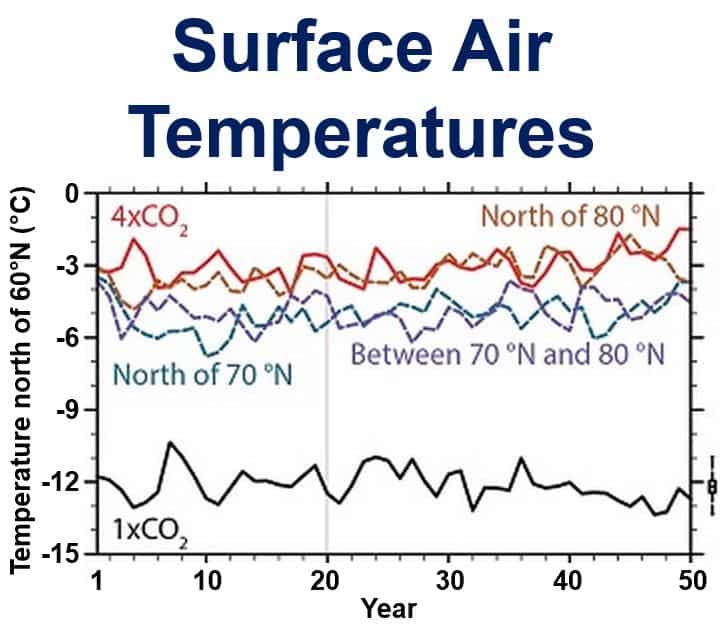Artificially whitening the surface of the Arctic Ocean will reflect more of the Sun’s energy back into space and restore much of the sea ice, but it will not result in substantial cooling. In other words, it will not stop global climate change, say researchers from the Carnegie Institution for Science, California Institute of Technology, and Lawrence Livermore National Laboratory, all of them in the United States.
Several studies have suggested that global warming could cause the frozen ground in the Arctic to melt, releasing huge amounts of methane, a potent greenhouse gas, into the atmosphere, thus exacerbating the rising temperatures across the planet.
Some scientists have proposed a range of geoengineering approaches to offset these disastrous climate effects. Artificially whitening the surface of the Arctic Ocean was one of them.

High-latitude surface air temperatures under different conditions simulated over a 5-decade period. Solid black line indicates current CO2 levels, solid red line depicts 4 x pre-industrial CO2 levels, blue dashed line represents alterations imposed to increase reflection of sunlight north of 70°N, brown dashed line represents alterations imposed to increase reflection of sunlight north of 80°N, purple dashed line represents alterations imposed to increase reflection of sunlight between 70 and 80°N. (Image: Carnigie)
Ivana Cvijanovic, Ken Caldeira and Douglas MacMartin set out to determine what the effect of Arctic Ocean whitening might be. They published their findings in the academic journal Environmental Research Letters (citation below).
No significant cooling
They concluded that an incredibly large effort might, in principle, restore huge amounts of sea ice by this method, however, it would not result in significant cooling. Consequently, it would not be an effective way of keeping the ground frozen in the Arctic.
Lead author Dr. Cvijanovic, who works at the Lawrence Livermore National Laboratory (previously Carnegie), said:
“By the middle of the century, the Arctic Ocean is predicted to be ice-free during part of the year. This could create substantial ecological problems in the Arctic, including habitat range changes and loss of biodiversity.”
An ice-free Arctic Ocean for part of the year could be devastating for indigenous communities, the authors add.
Dr. Cvijanovic added:
“However the problem is not only local – a number of studies have indicated that Arctic sea ice loss can affect weather patterns across the northern mid-latitudes, including Europe, most of North America, and much of Asia.”
Floating micro-bubbles or grains
The feasibility of whitening the Arctic Ocean is still being discussed. Proposals include floating micro-bubbles or grains that would reduce the amount of the Sun’s rays that would be absorbed.
However, more important than determining whether this could be done, the researchers point out, is to determine whether it might have the desired environmental impact if implemented.
Dr. Cvijanovic and colleagues used specially developed model configurations to study how Arctic whitening would be expected to play out in a planet with four times the pre-industrial amount of atmospheric CO2, and an Arctic that is around 10°C (18°F) warmer.
Effective in restoring much of the sea ice
When feeding these sorts of data into their Arctic whitening models, they found it could restore some of the sea ice – approximately three-quarter of a square kilometer of ice for every whitened square kilometer (same proportion in square miles).
However, ocean whitening would only have a ‘modest’ cooling effect, and would probably not do very much to maintain permafrost (the thick subsurface layer of soil that remains below freezing point all year round) and prevent the release of methane.
Their findings also suggested that ocean whitening and sea recovery would probably affect the climate far outside the Arctic region.
US weather might change
Dr. Cvijanovic explained:
“Ocean whitening and the sea ice recovery achieved in this way could lead to wetter and milder winter conditions in the southwestern United States and cooler conditions in the eastern United States.”
Dr. Caldeira, who works at Carnegie’s Department of Ecology, said:
“Simply put, our results indicate that whitening the surface of the Arctic Ocean would not be an effective tool for offsetting the effects of climate change caused by atmospheric greenhouse gas.”
“Furthermore, it is not clear to me that there is a technologically feasible way of actually doing this, and even if you could do it, the direct negative consequences of reducing the amount of sunlight available to marine ecosystems could be huge.”
The scientists pointed out, however, that this type of whitening approach might be effective on a smaller scale, maybe in an individual estuary or bay, rather than a whole ocean.
Citation: “Impacts of ocean albedo alteration on Arctic sea ice restoration and Northern Hemisphere climate,” Ivana Cvijanovic, Ken Caldeira and Douglas G MacMartin. Enviromental Research Letters. Published 28 April, 2015. DOI: 10.1088/1748-9326/10/4/044020.
Carnegie Video – September Sea Ice
An animation of the scientists’ findings.
